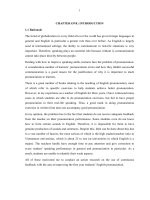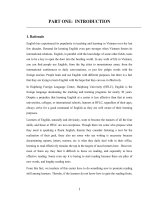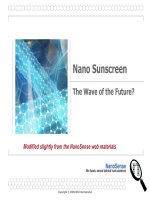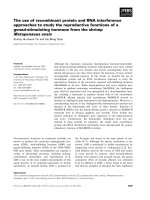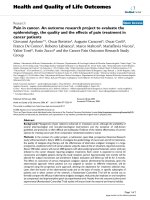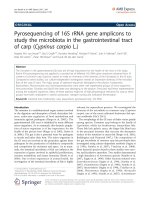Research report: "To study the effect of substituents on the properties of aniline by the method of approximate quantum AM1" pps
Bạn đang xem bản rút gọn của tài liệu. Xem và tải ngay bản đầy đủ của tài liệu tại đây (105.83 KB, 6 trang )
§¹i häc Vinh T¹p chÝ khoa häc, tËp XXXVI, sè 1A-2007
77
Studying substituent effects on the properties of
aniline with approximate quantum chemistry method AM1
Truong Van Nam
(a)
, Nguyen Xuan Dung
(a)
Abstract. Substituents effects on the properties of aniline were studied by
approximate quantum chemical methods using HyperChem software 7.52 (latest
version). AM1 method has been used to optimize geometry and calculate some
properties of molecules. The results show that substituents on the phenyl ring alter the
bond length C-N(d(C-N)), charge on atom N of amino group (QN), dipole moment(µ)
and the pKa of compounds.
There is a good correlation between these properties and Hammett σ constants,
which traditionally have been used to characterize quantitatively the substituent
electronic effect, except for d(C-N), QN of meta substituted compounds.
I. Introduction
The influence of substituents on physical and chemical properties of
compounds has attracted much interest in chemistry. Generally, substituents
change reactivities, conformations, equilibrium relationships, spectra, and thermal
properties of the substituted compounds.
Aniline is an interesting object to study the influence of substituents. Aniline
molecule was studied well [1-5]. On the basis of resonance theory, electron -
withdrawing constituents, especially at the para position, should favor quinoid
resonance structures, which are more planar than aniline itself, decreasing both
negative charge on N atom and the C-N bond length. Conversely, electron-donating
substituents should favor KekulÐ-type structures with more nearly tetrahedral
conformations at the nitrogen atom and increase charge on N atom and d(C-N) bond
length [6].
N
H
H
X
N
H
H
X
N
H
H
X
N
H
H
X
X
N
H
H
HyperChem is a sophisticated molecular modeling environment that is
known for its quality, flexibility, and ease of use. It unites 3D visualization and
animation with quantum chemical calculations, molecular mechanics, and dynamics
[7].
‘
NhËn bµi ngµy 07/8/2006. Söa ch÷a xong 05/10/2006.
§¹i häc Vinh T¹p chÝ khoa häc, tËp XXXVI, sè 1A-2007
78
HyperChem Release 7.52 is a full 32-bit application, developed for the
Windows 95, 98, NT, ME, 2000 and XP operating systems. HyperChem Release 7.5
incorporates even more powerful computational chemistry tools than ever before, as
well as newly incorporated modules, additional basis sets, new drawing capabilities
and more.
In this article, we used HyperChem software 7.52 to study the influence of
substituents on some properties of compounds.
II. Methods
Hammett constants for the substituents were taken from [8]. The pKa values
for the aniline derivatives were taken from [9].
Quantum chemical calculations were performed using HyperChem 7.52. To
optimize geometry of molecules, we used AM1 method. Statistical analyses were
done by EXCEL program.
III. Results and discussion
To simplify the analysis of substituent effects, we restricted our attention to
four representative properties: the C-N bond length (d(C-N)), charge on atom N (Q
N
),
dipole moment(µ) and the acid dissociation constant (pKa).
The results of geometry optimization of aniline by AM1 method are shown in
the Table 1. The obtained values are reasonable close to the experimentally
observed ones [10] but for <HNH bond angle. Therefore, we used this method to
optimize aniline derivatives.
Table 1. Some properties of aniline optimized by AM1 method.
C-N C-Ctb N-H <HNH
AM1
experimental
value
AM1
experimental
value
AM1
experimental
value
AM1
experimental
value
1.400
1.400 1.395
1.392 0.988
0.998 119.9
113.9
Substituent effects on properties of aniline derivatives were examined by
AM1 method. Calculated results for d(C-N), Q
N
and µ of its meta - and para-
substituted derivatives are shown in table 2.
Table 2. Calculated properties, Hammett constants and experimental pKa
value for aniline derivatives.
Order substituents
d(C-N)
(A
0
)
Q
N
µ σ
pKa
1 H- 1.3989 -0.410
1.584
0.00 4.58
2 m-amino 1.4000 -0.407
1.528
-0.16 4.88
3 m-bromo 1.3945 -0.398
2.717
0.39 3.51
4 m-chloro 1.3939 -0.398
2.603
0.37 3.34
5 m-cyano 1.3937 -0.398
4.438
0.56 2.76
6 m-fluoro 1.3941 -0.399
2.825
0.34 3.59
7 m-hydroxy 1.3950 -0.400
1.347
0.12 4.17
§¹i häc Vinh T¹p chÝ khoa häc, tËp XXXVI, sè 1A-2007
79
8 m-methoxy 1.3971 -0.398
2.342
0.12 4.20
9 m-methyl 1.3990 -0.402
1.416
-0.07 4.69
10 m-nitro 1.3932 -0.398
6.303
0.71 2.50
11 p-amino 1.4102 -0.422
0.000
-0.66 6.08
12 p-bromo 1.3947 -0.404
3.304
0.23 3.91
13 p-chloro 1.3956 -0.407
3.086
0.23 3.98
14 p-cyano 1.3832 -0.398
5.446
0.66 1.74
15 p-fluoro 1.402 -0.409
3.285
0.06 4.65
16 p-hydroxy 1.4083 -0.415
2.354
-0.37 5.50
17 p-methoxy 1.4075 -0.410
1.879
-0.27 5.29
18 p-methyl 1.4017 -0.412
1.432
-0.17 5.12
19 p-nitro 1.3783 -0.386
7.640
0.78 1.02
The variations observed for the bond length d(C-N) upon substitution are
seen to be relatively small. Electron-donating substituents tend to slightly increase
d(C-N), whereas electron-withdrawing substituents slightly decrease this bond
length. As expected, meta substituents exert a smaller influence than do para
substituents, although, with the exception of p-cyano, p-nitro groups. A fair
correlation between d(C-N) and the Hammett σ values of the substituents is found :
d(C-N) = -0.0071σ + 1.3972 ; R
2
= 0.6225(meta substituents);
d(C-N) = -0.0229σ + 1.3992; R
2
= 0.9454 (para substituents);
R=the correlation coefficient. This is illustrated in Figure 1.
m-: d(C-N) = -0.0071
σ
+ 1.3972
R
2
= 0.6225
p-: d(C-N) = -0.0229
σ
+ 1.3992
R
2
= 0.9454
1.3750
1.3800
1.3850
1.3900
1.3950
1.4000
1.4050
1.4100
1.4150
1.4200
-1 -0.5 0 0.5 1
σ
σσ
σ
d(C-N)
m-
p-
Fugure 1. Correlation of the bond length d(C-N) with the Hammett σ
constants of the substituents.
The para substituents show a much better correlation with d(C-N) (R
2
=
0.9454) than do the meta substituents (R
2
=0.6225). The para substituents have a
greater effect on the C-N bond length (angle factor =-0.0229) than do the meta
substituents( angle factor =-0.0071).
The correlation between Q
N
and Hammett constants was also examined :
Q
N
= 0.0109σ - 0.4034 ; R
2
= 0.5007 (meta substituents);
Q
N
= 0.0208σ - 0.4081 ; R
2
= 0.9057 ( para substituents).
§¹i häc Vinh T¹p chÝ khoa häc, tËp XXXVI, sè 1A-2007
80
The results show that electron-donating substituents increase nagative
charge on N meanwhile electron-withdrawing substituents have opposite effect.
However, para-subtituted compounds are much better fit(R
2
= 0.9057) than meta-
substituted compounds (R
2
= 0.5007).
p-: QN = 0.0208
σ
- 0.4081
R
2
= 0.9057
m-: QN= 0.0109
σ
- 0.4034
R
2
= 0.5007
-0.430
-0.420
-0.410
-0.400
-0.390
-0.380
-1 -0.5 0 0.5 1
σ
σσ
σ
Q
N
m-
p-
Fugure 2. Correlation of Q
N
with the Hammett σ constants of the
substituents.
According to the table 2, electron-donating substituents decrease the dipole
moment of compounds and electron-withdrawing substituents have opposite results.
The para substituents show better correlation with µ (R
2
=0.8552) than do the meta
substituents (R
2
=0.8108). The meta substituents is more effective than the para
ones because angle factor of m - line is greater than angle factor of p-line.
µ = 5.0230 σ + 1.5148 ; R
2
= 0.8108 (meta substituents);
µ = 4.5064 σ + 2.7802 ; R
2
= 0.8552 (para substituents).
m-:
µ
= 5.023
σ
+ 1.5148
R
2
= 0.8108
p-:
µ
= 4.5064
σ
+ 2.7802
R
2
= 0.8552
-1
0
1
2
3
4
5
6
7
8
-0.8 -0.6 -0.4 -0.2 0 0.2 0.4 0.6 0.8
σ
σσ
σ
µ
µ
µ
µ
p-
m-
Figure 3. Correlation of the dipole moment µ with the Hammett σ constants
of the substituents.
It is evident from the table II that electron-donating substituents on the
phenyl ring increase the pKa of aniline’s amino group, and electron-withdrawing
substituents decrease the pKa. Hammett σ constants were initially developed to
§¹i häc Vinh T¹p chÝ khoa häc, tËp XXXVI, sè 1A-2007
81
describe the electronic influences of substituents on chemical reactions and
equilibria. Accordingly, it is reasonable to expect that they might also provide a
reliable measure of the substituent’s effects on the pKa of the amino moiety, and
this is indeed the case:
pKa = -2.8437σ + 4.4898 ; R
2
= 0.9892 (meta substituents);
pKa = -3.5197σ + 4.335 ; R
2
= 0.9403 (para substituents).
In this case, the meta derivatives are better fit (R
2
= 0.9892) than the para
derivatives (R
2
=0.9403).
m- :pKa = -2.8437
σ
+ 4.4898
R
2
= 0.9892
p-: pKa = -3.5197
σ
+ 4.335
R
2
= 0.9403
-1
1
3
5
7
9
-0.8 -0.6 -0.4 -0.2 0 0.2 0.4 0.6 0.8 1
σ
σσ
σ
pKa
m-
p-
Figure 4. Correlation of the pKa value with the Hammett σ constants of the
substituents.
Table 3 lists correlation coefficients between Hammett σ constants and bond
length C-N, negative charge on atom N, dipole moment and the pKa of
compounds.
Table 3. Correlation coefficients among the properties studied.
meta substituents para substituents
d(C-N) 0.6225 0.9454
Q
N
0.5007 0.9057
µ
0.8108 0.8552
pKa 0.9892 0.9403
It is apparent from the information in the table 3 that for d(C-N), Q
N
and µ,
para substituents provide better correlation than meta substituents, and for pKa, it
shows contrary results.
IV. Conclusion
The semi-empirical AM1 level calculation performs well in terms of its
geometrical description of aniline as indicated by the close agreement with the
experimental bond lengths.
As one would anticipate from general principles, electron-withdrawing
substituents enhance planarity of the aniline framework, thereby shortening d(C-
N). The accompanying loss of electron density from the amino nitrogen atom
decreases the pKa of the amino group. Conversely, electron-donating substituents
favor pyramidal sp
3
hybridization at the amino nitrogen, leading to a longer C-N
Đại học Vinh Tạp chí khoa học, tập XXXVI, số 1A-2007
82
bond length. Also, the pKa of the amino nitrogen is increased by electron-donating
substituents.
The variations of the three properties are closely tied together. Hammett
constants which used as regression indicator to investigate the change of
properties yield rather good correlations for these properties except for d(C-N), Q
N
of
meta derivatives. The correlation of pKa with is best fit.
References
[1] Lister, D. G.; Tyler, J. K. Chem Commun, (1966), 152153.
[2] Lister, D. G.; Tyler, J. K.;Hỉg, J. H.;Larsen, N. W. J Molec. Struct, 23 (1974),
253264.
[3] Brand, J. C. D.; Williams, D. R.; Cook, T. J. J Molec. Spectrosc, 20(1966), 193
195.
[4] Brand, J. C. D.; Jones, V. T.; Forrest, B. J.; Pirkle, R. J. J Molec. Spectrosc,
39(1971), 352356.
[5] Quack, M.; Stockburger, M. J Molec Spectrosc, 43(1972) , 87-116.
[6] Kenvin C. Gross, Paul G. Seybold, International Journal of Quantum Chemistry,
80((2000),1107-1115.
[7]
[8] Hansch, C.; Leo, A.; Taft, R. W. Chem Rev, 91(1991), 165195.
[9] Albert, A.; Serjeant, E. P. Ionization Constants of Acids and Bases; Methuen:
London, 1962.
[10] David R.Lide, CRC Handbook of Chemistry and Physics, 75 ed, CRC press,
London (1994), 9-50.
Tóm tắt
Nghiên cứu ảnh hởng của nhóm thế lên tính chất
của anilin bằng phơng pháp lợng tử gần đúng AM1
ảnh hởng của nhóm thế lên tính chất của aniline đợc nghiên cứu bằng phơng
pháp tính hoá lợng tử gần đúng sử dụng phần mềm HyperChem phiên bản 7.52.
Phơng pháp AM1 đợc dùng để tối u phân tử và tính các tham số cấu trúc. Kết
quả nghiên cứu cho thấy nhóm thế làm thay đổi độ dài liên kết C-N, điện tích trên
nguyên tử N, mômen lỡng cực và giá trị pKa của các dẫn xuất thế. Hằng số
hammett đặc trng định lợng cho ảnh hởng của nhóm thế có sự tơng quan khá
tốt đối với các thuộc tính này ngoại trừ độ dài liên kết C-N và điện tích trên nguyên
tử N của dẫn xuất thế meta.
(a)
Khoa hoá học, trờng đại học Vinh

